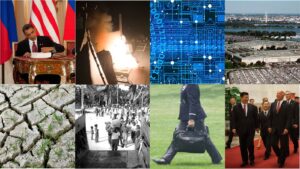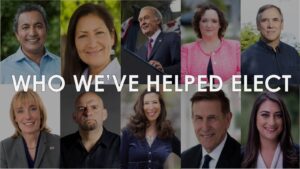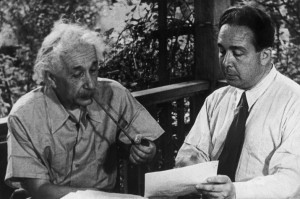“When I came to you with those calculations, we thought we might start a chain reaction that might destroy the entire world.”
“What of it?”
“I believe we did.”
The powerful last lines of Christopher Nolan’s Oppenheimer, an exchange between Albert Einstein and J. Robert Oppenheimer, illustrate why an organization like ours matters more today than ever. Whether you felt compelled to take action to reduce nuclear dangers after watching Oppenheimer or something else brought you to us, welcome! We are so glad you are ready to help us rid the world of nuclear threats.
The Threat That Never Went Away
We survived a period of high nuclear danger during the Cold War, but the threat is again growing. Imaginative diplomacy and public engagement helped us avoid Oppenheimer’s nightmare once and are needed again. The warnings of the Manhattan Project scientists are still relevant today.
Every nuclear-armed country is growing or modernizing its arsenal.
The chief task was to stop the arms race before it brought utter disaster. However, after the collapse of communism and the disintegration of the Soviet Union, any rationale for having nuclear weapons disappeared. The quest for their total elimination could be resumed. But the nuclear powers still cling tenaciously to their weapons. –Joseph Rotblat, 1995
The smallest strategic weapons today are much larger than the ones that destroyed Hiroshima and Nagasaki, and the smallest nuclear arsenal is enough to cause an unimaginable environmental disaster.
I have been asked whether, in the years to come, it will be possible to kill 40 million American people in the 20 largest American towns by the use of atomic bombs in a single night. I am afraid that the answer to that question is yes. –J. Robert Oppenheimer, October 1945
Russian leaders hurl threats to use nuclear weapons on non-nuclear countries and use their nuclear weapons as blackmail against all who would oppose them.
If we intend to drop our bombs on Russia in case of war, and expect Russia to drop her bombs on us, so that both countries would be wholly devastated, then our threat to drop bombs on Russia is tantamount to a threat of murder and suicide. –Leo Szilard, 1962
Our Founder’s Fight
Our founder, physicist Leo Szilard, who was played by Máté Haumann in the Nolan film, worked with Einstein to convince President Franklin Roosevelt to launch the Manhattan Project to counteract a potentially nuclear Nazi Germany.
During the Manhattan Project, he led the Metallurgical Laboratory in Chicago. After Germany’s defeat and before the United States dropped the bomb in Hiroshima, Szilard gathered 70 scientists to sign a petition urging President Harry Truman not to bomb Japan without offering Japan the chance to surrender first. They warned of an atomic future with “almost no limit to the destructive power.” They warned of an arms race that would lead all cities worldwide to be in “continuous danger of sudden annihilation.”
After the Trinity Test
The petition never made it to Truman, but we have seen every day since August 6, 1945 how right Szilard and those scientists were. Hundreds of thousands of people have died or been sentenced to lifelong and generational struggles because of nuclear weapons production, testing and use in warfare.
Szilard spent the rest of his life trying to contain the weapons he helped create. After 16 years of voicing his concerns about the nuclear arms race, an idea came to him in October 1961: combine reason with political action.
Thus, in 1962, Council for a Livable World was born. Since then, we’ve endorsed and helped elect more than 400 Members of Congress — Democrats, Republicans and Independents — who have fought to contain unnecessary Pentagon spending, vote in favor of agreements to limit nuclear threats and arsenals, and support a diplomacy-first foreign policy.
What Has Gotten Rid of Nuclear Weapons Before
Since the height of the Cold War, arms control agreements have reduced the global nuclear stockpile from 70,000 to just under 13,000 today. Many of those agreements have followed massive public awareness and pressure to make the world safer from these indiscriminate weapons of mass destruction. That tremendous progress has stalled and we need your help to get back on track and eventually get the number of nuclear weapons down to zero.
So, what can you do? How can you help get rid of nuclear weapons?
 1. Get informed about nuclear policy, but not intimidated by it. Take a look at the issues we’re currently engaging Congress on so you can understand how nuclear weapons issues affect all of us today. Learn about the ways in which climate change and nuclear weapons are inextricably linked. Learn about why nuclear justice is gender justice, racial justice and economic justice.
1. Get informed about nuclear policy, but not intimidated by it. Take a look at the issues we’re currently engaging Congress on so you can understand how nuclear weapons issues affect all of us today. Learn about the ways in which climate change and nuclear weapons are inextricably linked. Learn about why nuclear justice is gender justice, racial justice and economic justice.
Talk to your friends and loved ones about your concerns related to nuclear weapons. And remember that you don’t have to know everything about a complex topic to have a valid opinion on it. In fact, bringing viewpoints that are not traditional to nuclear weapons advocacy into the broader public discussion is immensely valuable and something we wholeheartedly encourage. Your life would change in the event of a nuclear catastrophe, and that alone gives you the right to talk about it.
2. Tell your Senators and Representative in Congress that you want them to take action. Several bills in Congress would make us safer by involving more people — and limiting AI’s role — in the nuclear launch process; cutting funds for unnecessary and dangerous nuclear weapons systems; and mitigating the risks of accidents or miscalculations by increasing transparency among nuclear states. There are also bills to provide long-overdue compensation and justice for communities harmed by nuclear production and testing. Use our site to email your Members of Congress directly on key bills, then join our email list and follow us on social media to be the first to know about timely and necessary actions you can take.
3. Donate to candidates who will support smart nuclear arms control and non-proliferation policies, fight for a more accountable Pentagon budget and prioritize diplomacy over conflict. Our 2024 election cycle is underway and we have made our first House and Senate endorsements for 2024 with many more to come. When you give to our endorsed candidates, 100% of your donation goes to them, but your donation is earmarked as coming from a supporter of nuclear arms control so these candidates will know nuclear threat reduction matters to you.
Historically, nuclear arms control is a nonpartisan issue and we’ve endorsed members of both major parties. Unfortunately, at the moment, that is no longer the case. As we seek to bring more rational nuclear policy ideas to Capitol Hill, we look forward to once again helping elect members from across the political spectrum.
4. Donate to us. We hate to ask, but times are tough. Organizations like ours have been losing monetary support since the height of the Cold War as more and more people have mistakenly thought all global nuclear problems were solved. Some anti-nuclear-weapons organizations have even had to close their doors forever. Our small staff is passionate about ending nuclear threats, but we can’t do it without your help. Becoming a donor today will allow us to continue our work advocating for smart nuclear threat reduction policies on Capitol Hill while endorsing and raising money for candidates who will support our goals.

